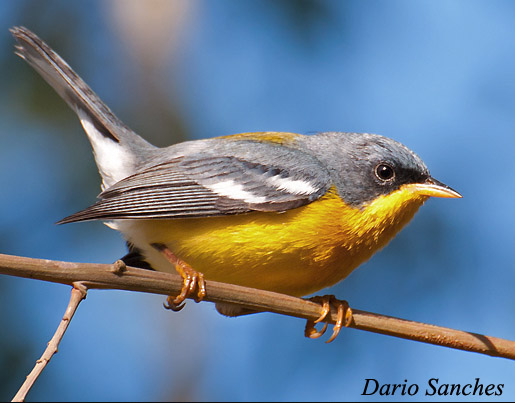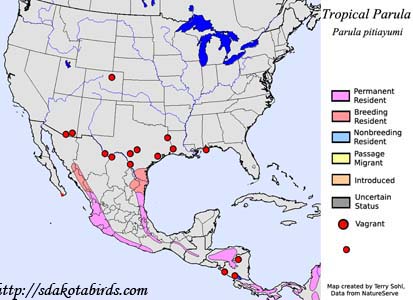| Length: 4.5 inches | Wingspan: 6.5 inches | Seasonality: Non-resident in South Dakota |
| ID Keys: Bluish-gray upperparts, yellow below, 2 white wingbars, olive patch on back | ||
 The
Tropical Parula is found from northern Mexico southward all the way to
Argentina, but also is a summer breeder in far southern Texas. Their range
seem to be expanding northward in Texas. The Tropical Parula was
formerly considered a form of the Northern Parula. After being separated as
a distinct species, it was originally called the "Olive-backed Parula"
before the current name was assigned. Within its range there are many
recognized subspecies with minor plumage, voice, and breeding distinctions.
The
Tropical Parula is found from northern Mexico southward all the way to
Argentina, but also is a summer breeder in far southern Texas. Their range
seem to be expanding northward in Texas. The Tropical Parula was
formerly considered a form of the Northern Parula. After being separated as
a distinct species, it was originally called the "Olive-backed Parula"
before the current name was assigned. Within its range there are many
recognized subspecies with minor plumage, voice, and breeding distinctions.
Habitat: Found mostly in oak forests in the Texas portion of its range, typically thick forests with significant growth of Spanish Moss.
Diet: Feeds mostly on insects and spiders, but they will occasionally take berries as well.
Behavior: Feeds by actively moving through the foliage of the forest canopy, gleaning insects from vegetative surfaces. They also may fly out to capture flying insects in mid-air. They often will forage very low in the forest canopy, in the forest undergrowth, or even by hopping along the ground.
Nesting: The nest is typically a hollowed out ball of Spanish Moss or similar vegetation hanging on tree branches. The nest typically has a sparse lining of hair, grass, feathers, or other fine material. The female usually lays three eggs (between two and five), and she does most of the incubating.
Song: Song is a thin buzzy trilling.
Migration: Most Tropical Parulas are considered permanent residents, but most of those at the north end of their range, including those in Texas, are migratory, moving southward a short distance in the winter. Note that a few do generally linger even in the northern part of their range, with Tropical Parulas occasionally found in winter along the Rio Grande in Texas.
Interactive eBird map: Click here to access an interactive eBird map of Tropical Parula sightings
Similar Species: Northern Parula. They can be distinguished from the Northern Parula by the lack of obvious eye-crescents, among other ID marks.
Conservation Status: Populations of the Tropical Parula appear to be increasing, and they are found over a very wide geographic area. The IUCN lists the Tropical Parula as a species of "Least Concern".
Further Information: 1) BirdLife International - Tropical Parula
2) WhatBird - Tropical Parula
3) Cornell's NeoTropical Birds - Tropical Parula
Photo Information: Photo by Dario Sanches - Photo licensed under Creative Commons Attribution ShareAlike 2.0 Generic License
| Click below for a higher-resolution map |
 |
| South Dakota Status: Non-resident in South Dakota |
Additional Tropical Parula Photos (coming soon!!)
